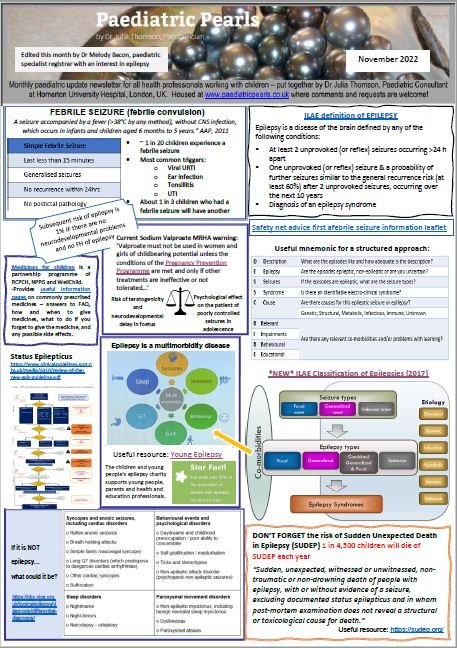This month’s newsletter is all about epilepsy, with thanks to one of the senior registrars working at Homerton currently who has a special interest in epilepsy. Useful updates and links. Please do leave comments below.


This month’s newsletter is all about epilepsy, with thanks to one of the senior registrars working at Homerton currently who has a special interest in epilepsy. Useful updates and links. Please do leave comments below.

This month‘s newsletter has 2 updates on the new anaphylaxis guideline for people working in EDs, and a rethink about the amount of salbutamol we send children home from hospital with. A bit about the role of the educational psychologist and a reminder that, although usually benign, not all premature thelarche is transient. Do leave comments below:
A mixture of topics this month again. Estimating testicular volume without an orchidometer, correcting for gestational age on growth charts, Resus Council update and the ins and outs of using photographs in virtual consultations. Do leave comments below.
Remote assessment of children the Wessex way this month, tight foreskins, difficult airways and a journal club discussion around the likelihood of meningitis in neonatal UTI. Do leave comments below…
With thanks to Dr Cate Luce:
Here is a systematic approach to burns using an ABCDE approach.
A: Is their airway compromised?
Consider in:
For more information: https://dontforgetthebubbles.com/picu-qa-airway-injuries-due-burns/ 1
B: Basic first aid
Adequate pain relief is essential in burns. You should use something fast-acting such as intranasal diamorphine or follow your local policy. This will allow for a better assessment of the extent of the burns and delivery of basic first aid. Don’t forget running cold water on the affected area for at least 20 minutes, which may be effective up to 3 hours after the burn. First aid steps at https://cks.nice.org.uk/burns-and-scalds.
C: Calculate the percentage of total body surface area (TBSA)
There are several methods to calculate the percentage of TBSA. The palmar aspect of a child’s hand is 1% of a child’s surface area. You can use the Lund and Browder charts.
https://em3.org.uk/foamed/25/10/2015/remember-remember-burns-and-blasts 2
People often overestimate the percentage of TBSA affected; remember to only include partial and full thickness burns as defined at www.cks.nhs.uk/burns_and_scalds3.
Why not make it easy for yourself and download the Mersey Burns App4, which calculates the percentage of burns for you?
Children with more than 10% of TBSA will need intravenous fluids. The app also calculates the fluid required using the Parkland Formula (3-4ml x (%TBSA) x (weight kg)). You should give half in the first 8 hours followed by the rest within the next 16hours.
D: Discussion with burns centre
D: Disabilities– what are the complications?
E: External factors
Burns can be a result of neglect or physical abuse therefore safeguarding should always be considered. All children should be referred to their Health Visitor who is responsible for talking to the family about safety in the home – even if you feel it was an accident. Use the Child Protection Companion as a guide. https://www.rcpch.ac.uk/sites/default/files/2019-09/child_protection_evidence_-_burns.pdf 6
Always check the child’s immunisation status, especially tetanus, as burns can act as a tetanus-prone wound.
References
The 2nd Paediatric and Neonatal Cardiac Emergencies Course is being run at Homerton University Hospital in London again this April. The expert faculty come from Great Ormond Street Hospital, Evelina, Homerton and Barts Health. Paediatric cardiologists, simulation trainers, neonatologists and paediatricians with expertise in cardiology and life support instructors. Do come along for a fun if somewhat intensive couple of days of defibrillation, terrifying talks on QT intervals, enlightening workshops and – acting on feedback from candidates who just couldn’t get enough last year – no less than 6 full immersion simulations. Application forms from the e-mail address on the flyer.
Flyer available to download from http://www.paediatricpearls.co.uk/wp-content/uploads/2020/01/Cardiology-Course-Flyer-April-2020.pdf . You’ll need lots of blue ink in your colour printer – sorry.
September’s newsletter reminds us of the CPD requirements for child safeguarding for all of us, warns us of the dangers of missing Kawasaki Disease, talks about PHE’s #askaboutasthma campaign and describes the differences between fever and sepsis. Do leave comments below:
Local anaesthetic cream this month (why do some places not use it in the under 1’s?), a link to useful “flash card” learning in the paediatric ED from Leicester, new Movicol doses, diphtheria and the last instalment of urinalysis with bilirubin and urobilinogen. A reminder also to please discuss children with glycosuria and a high BM with a paediatrician – most children have type 1 diabetes and are at risk of DKA at diagnosis. Do leave comments below:
Ambulatory Blood Pressure Monitoring this month, re-housed NSPCC leaflets, ketonuria and lignocaine in intraosseous fluids and fluid intake in constipated children. Do leave comments below.